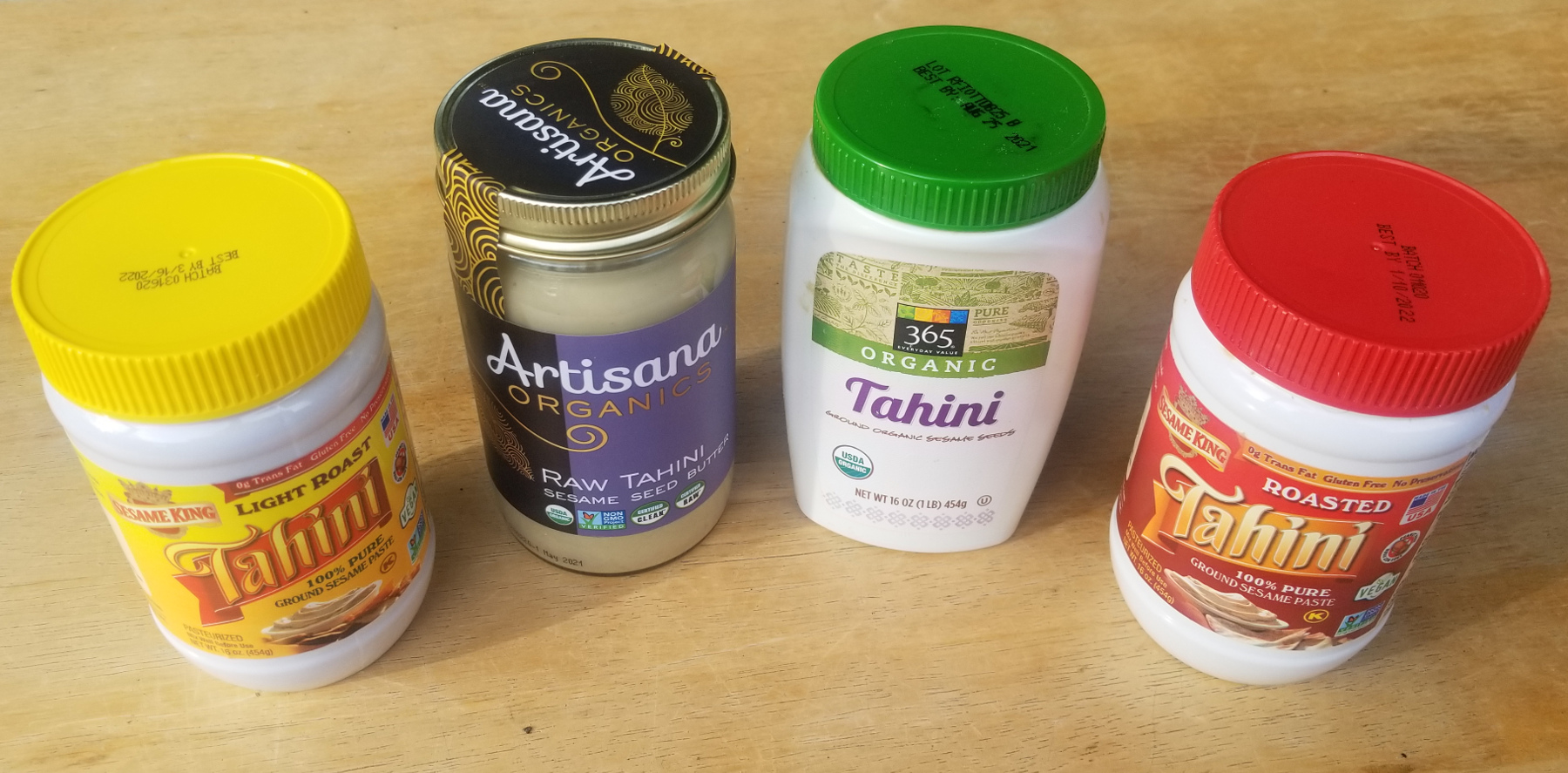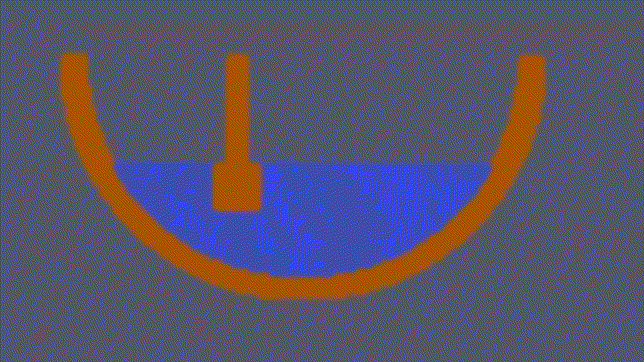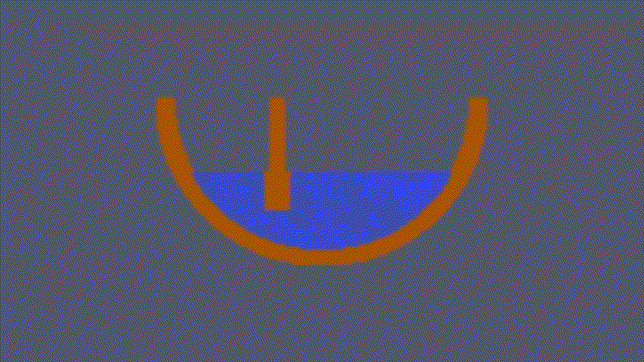Background
Tahini is amazing. A condiment made from toasted ground hulled sesame, tahini can be added to a variety of dishes and drinks to improve taste, texture and nutritional value.
Tahini is best when purchased as 100% sesame paste.

To prepare it, water, lemon and favorite spices are slowly added and stirred. In this process, something very odd happens. The tahini at room temperature starts as a viscous fluid. As water is added to the mixture, the tahini goes through a phase shift and becomes granular solid. As more water is added, the tahini returns to a fluid and delicious state.
Video demonstration (2X speed):
Notice that while sharing certain similarities, Tahini is not a “classical” non-Newtonian fluid, which exhibits phase shifts as response to stress. Tahini’s phase is defined the amount of water in the system, and the solid phase is dependent on “just the right amount” - too little or too much water, and tahini is still liquid (viscous, but liquid). Not exhibited in the video, having the right amount for a long time creates such a solid piece of Tahini that it might break a blender. Be careful.
This process is sometimes described as “seizing” and is not unique to Tahini. Peanut butter, as well as non edible materials such as plaster, are known to seize up water and solidify before going to liquid state. This happens as small amounts water act as a cross-linker between molecules. We assume a similar process happens for tahini, while the liquid starting point is due to the high oil concentration.
Lets start from the end
Tahini phase shift is simulated using PySPH, a powerful framework for fluid simulation. The system contains two types of particles: tahini and solid (bowl/spoon). The tahini particles contain a property which corresponds to the amount of H2O arund that particle. In addition to classical fluid flow equations, as well as rigid body motion equation to move the spoon - a new equation was introduced to the system: Weighted Lennard Jones Interaction. Every two particles exhibit a Lennard Jones potential dependent on a Gaussian of the sum of H2O for both particles. Thus simulating H2O dependent crosslinking of Tahini. Kind of.
The Basics
The code is based on hydrostatic_tank example from PySPH, where fluid particles are floating in a tank. Each PySPH program basically contains three parts: particles, equations and a solver. First, I will describe the 2D version of fluid siumlation in a bowl mixed by a spoon (no phase shifts, yet)
Create the Particles
We create a bowl, tahini and a mixing spoon. We create a uniform mesh grid:
# dimensions
Lx = 2.0
Ly = 1.0
Cx = 1.0
Cy = 1.0
bowlR = 1.0
tahiniH = 0.5
# the higher this number, the more refined the simulation is (and the longer it takes...)
nx = 100
dx = Lx / nx
ghost_extent = 5.5 * dx
_x = np.arange(-ghost_extent, Lx + ghost_extent, dx)
_y = np.arange(-ghost_extent, Ly, dx)
x, y = np.meshgrid(_x, _y)
x = x.ravel()
y = y.ravel()
And create objects based on particle coordinates.
Bowl (hollow half sphere)
p_bowl = []
for i in range(x.size):
r = (x[i] - Cx)**2 + (y[i] - Cy)**2
if r > bowlR**2 and r < (bowlR + ghost_extent)**2:
p_bowl.append(i)
x_bowl = x[p_bowl]
y_bowl = y[p_bowl]
Spoon (funky shape)
p_spoon = []
for i in range(x.size):
if y[i] > 0.25 and ((x[i] > 0.6 and x[i] < 0.8 and y[i] < tahiniH) or (x[i] > 0.66 and x[i] < 0.74)):
p_spoon.append(i)
x_spoon = x[p_spoon]
y_spoon = y[p_spoon]
Tahini (sphere minus spoon)
p = []
for i in range(x.size):
if i in p_spoon:
continue
r = (x[i] - Cx)**2 + (y[i] - Cy)**2
if r < bowlR**2 and y[i] < tahiniH:
p.append(i)
x_tahini = x[p]
y_tahini = y[p]
Next, we define properties for each particle:
tahini.rho[:] = rho0
bowl.rho[:] = rho0
spoon.rho[:] = rho0
# mass is set to get the reference density of rho0
volume = dx * dx
# volume is set as dx^2
tahini.V[:] = 1. / volume
bowl.V[:] = 1. / volume
spoon.V[:] = 1. / volume
tahini.m[:] = volume * rho0
bowl.m[:] = volume * rho0
spoon.m[:] = volume * rho0
Define the Equations
The hydrostatic_tank contains three ways to check for the boundary between the solid and liquid particles:
-
Gesteria et al. “State-of-the-art of classical SPH for free-surface flows”, 2010, JHR, pp 6–27 (REF3)
REF2 requires special spacing between fluid and solid particles, and REF1 proved to be 75% slower in my experiments, so I’m using the third formulation:
equations3 = [
# For the multi-phase formulation, we require an estimate of the
# particle volume. This can be either defined from the particle
# number density or simply as the ratio of mass to density.
Group(equations=[
VolumeFromMassDensity(dest='tahini', sources=None)
], ),
# Equation of state is typically the Tait EOS with a suitable
# exponent gamma. The solid phase is treated just as a fluid and
# the pressure and density operations is updated for this as well.
Group(equations=[
TaitEOS(dest='tahini',sources=None,rho0=rho0,c0=c0,gamma=gamma),
TaitEOS(dest='bowl',sources=None,rho0=rho0,c0=c0,gamma=gamma),
TaitEOS(dest='spoon',sources=None,rho0=rho0,c0=c0,gamma=gamma),
], ),
# Main acceleration block. The boundary conditions are imposed by
# peforming the continuity equation and gradient of pressure
# calculation on the bowl phase, taking contributions from the
# tahini phase
Group(equations=[
# Continuity equation
ContinuityEquation(dest='tahini', sources=['tahini', 'bowl', 'spoon']),
ContinuityEquation(dest='bowl', sources=['tahini']),
ContinuityEquation(dest='spoon', sources=['tahini']),
# Pressure gradient with acceleration damping.
MomentumEquationPressureGradient(
dest='tahini', sources=['tahini', 'bowl', 'spoon'], pb=0.0, gy=gy,
tdamp=tdamp),
# artificial viscosity for stability
MomentumEquationArtificialViscosity(
dest='tahini', sources=['tahini', 'bowl', 'spoon'], alpha=1, c0=c0),
# Position step with XSPH
XSPHCorrection(dest='tahini', sources=['tahini'], eps=0.5)
]),
]
Each of these equations define a set of confitions that will be integrated over the ‘dest’ particles. In case of particle-particles interactions, the sources parameter defines each particle type. A few well studied (Monaghan 2005) SPH equations behind the scenes:
- ContinuityEquation - conservation of mass
- MomentumEquationPressureGradient - pressure
- MomentumEquationArtificialViscosity - viscosity
To move the spoon around, I defined a simple harmonic undamped force equation and applied it on the spoon particles:
class HarmonicOscilllator(Equation):
def __init__(self, dest, sources, A=4.0, omega=0.5):
self.A = A
self.omega = omega
super(HarmonicOscilllator, self).__init__(dest, sources)
def initialize(self, d_idx, d_au, d_av, d_aw, t):
d_au[d_idx] = self.A * cos(self.omega * 2 * M_PI * t)
Add it to the equations list:
...
# Spoon Equations
Group(equations=[
HarmonicOscilllator(dest='spoon', sources=None, A=0.5, omega=0.2),
# Translate acceleration to positions
XSPHCorrection(dest='spoon', sources=['spoon'], eps=0.0)
], real=False),
...
Solve it
Last, we define an kernel and integrator:
# Create the kernel
#kernel = Gaussian(dim=2)
kernel = CubicSpline(dim=2)
#kernel = QuinticSpline(dim=2)
integrator = PECIntegrator(tahini=WCSPHStep(), bowl=WCSPHStep(), spoon=WCSPHStep())
# Create a solver.
solver = Solver(kernel=kernel, dim=2, integrator=integrator,
tf=tf, dt=dt,
adaptive_timestep=False
)
And the results

The colors represents the velocity magnitude. Using 1500~ tahini particles, approximately 3 minutes to run on my laptop using multicore (OpenMPI)
It’s time to solidify our particle system
Now it’s time to make things more interesting, I decided to create the following model - each tahini particle hold a property which symbolizes the amount of H2O in its vicinity. Now we are going to make every two tahini particles interact using Van der Waals force, which we define by the Lennard Jones potential:

Where is a magic number that we have to choose for our settings. is the max distance at which two particles have an effect, and is the distance between the particles.
LJ potential are frequently used in molecular dynamics simulation, but haven’t been thoroughly investigated in the context of SPH until recently (Barbosa and Piccoli 2018 - comparison between LJ and Coulomb forces in SPH).
The force acting on two particles would be
And now comes the trick. We apply this force with a certain probability, a Gaussian which depends on the amount of H2O both particles have. So, if there is no water OR too much water, the particles will not be exhibit Van der Waals forces. If there is just the right amount (and ths we introduce another magic number, which can be experimentally found…)
We set $\mu = 1$ and $\sigma=1/12$, so low amount of water will exhibit nearly zero interaction force.
This, we get a new governing equation - Weighted Lennard Jones:
The code for the equation looks like:
class TahiniEquation(Equation):
def __init__(self, dest, sources, sigma):
self.eps = 0.5 # magic number
self.sigma = sigma # the distance in which particles have no effect
self.var = 12 # the inverse variance of the gaussian. we want this so e^(-1 * var) ~ 0
super(TahiniEquation, self).__init__(dest, sources)
def initialize(self, d_idx, d_au, d_av, d_aw):
d_au[d_idx] = 0.0
d_av[d_idx] = 0.0
d_aw[d_idx] = 0.0
def loop(self, d_idx, d_m, d_au, d_av, d_aw, s_idx, s_m, d_h2o_amount, s_h2o_amount, RIJ, XIJ):
if RIJ > 1e-9:
# Gaussian distrbution for tahini-water-tahini interaction
p = M_E ** (- (d_h2o_amount[d_idx] + s_h2o_amount[s_idx] - 1) ** 2 * self.var)
# Forced derived from Lennard-Jones potential
F_LJ = 24 * self.eps * (- 2 * (self.sigma ** 12 / RIJ ** 13) + (self.sigma ** 6 / RIJ ** 7))
# normal vector passing from particle i to j
nij_x = -XIJ[0] / RIJ
nij_y = -XIJ[1] / RIJ
nij_z = -XIJ[2] / RIJ
else:
p = 0.0
F_LJ = 0.0
nij_x = 0.0
nij_y = 0.0
nij_z = 0.0
d_au[d_idx] += p * F_LJ * nij_x
d_av[d_idx] += p * F_LJ * nij_y
d_aw[d_idx] += p * F_LJ * nij_z
And we add it to our equation list:
equations=[ ... TahiniEquation(dest='tahini', sources=['tahini'], sigma=dx / 1.122), ... ]
And we also need to set the new property to our tahini particles:
tahini.add_property('h2o_amount')
Using the exact same setup as before, but now we set every particle water content to 0.5 (the ideal), we now get:

Pretty solid!
Hold on a minute, couldn’t you just increase the viscosity?
If we look at the artificial viscosity equation (Monaghan 2005), we notice they are quite similar to our LJ potential… but what the LJ equation has is that two particles repel each other if they are too close. Thus, setting high numbers to the viscosity parameter, alpha, causes the simulation to crash. Alpha is set by default to 0.24 (water). I set it to 1 for tahini at a liquid state, and below is a simulation of the highest alpha I manually found that didn’t crash (5):

Not so solid…
There and back again: liquid-solid-liquid
Now it’s time for the final experiment. I add water to the system and watch as the tahini goes from liquid, to solid and back again. Instead of adding water to the whole system at once, we are going to trickle it. I create a faucet, and area/volume in the particle system where H2O is refilled harmonically:
class H2OFaucet(Equation):
"""Applies a "faucet" - constant refill of H2O for a specific subset of particles"""
def __init__(self, dest, sources, x, y, r, fill_rate, lag=4):
self.faucet_x = x
self.faucet_y = y
self.faucet_r2 = r ** 2
self.faucet_fill_rate = fill_rate
self.omega = 0.5
self.lag = lag
super(H2OFaucet, self).__init__(dest, sources)
def initialize(self, d_idx, d_h2o_amount, d_x, d_y, t, dt):
if t > self.lag and (d_x[d_idx] - self.faucet_x) ** 2 + (d_y[d_idx] - self.faucet_y) ** 2 < self.faucet_r2:
d_h2o_amount[d_idx] += self.faucet_fill_rate * dt * (sin(self.omega * 2 * M_PI * t) ** 2)
And we add another equation that will diffuse the water through the system. This PySPH equation was taken from Alexander Puckhaber’s thesis project:
class DiffuseH2O(Equation):
"""Diffusion of H2O between particles """
def __init__(self, dest, sources, diffusion_speed):
self.diffusion_speed = diffusion_speed
super(DiffuseH2O, self).__init__(dest, sources)
def initialize(self, d_idx, d_h2o_velocity):
d_h2o_velocity[d_idx] = 0.0
def loop(self, d_idx, s_idx, d_h2o_velocity, s_h2o_velocity, d_h2o_amount, s_h2o_amount, WIJ):
h2o_gradient = (s_h2o_amount[s_idx] - d_h2o_amount[d_idx])
d_h2o_velocity[d_idx] += ( h2o_gradient * self.diffusion_speed ) * WIJ
s_h2o_velocity[s_idx] -= ( h2o_gradient * self.diffusion_speed ) * WIJ
def post_loop(self, d_idx, d_h2o_amount, d_h2o_velocity, dt, t):
d_h2o_amount[d_idx] += d_h2o_velocity[d_idx] * dt
We add those equations to the list:
Group(equations=[
H2OFaucet(dest='tahini', sources=None, x=Cx, y=tahiniH, r=0.15, fill_rate=5),
DiffuseH2O(dest='tahini', sources=['tahini'], diffusion_speed=0.1),
]),
The magic numbers of fill_rate, faucet size and diffusion size were chosen so water doesn’t overflow the system to quickly and we can see the phase shift.
And here is the results:
Each particle is colored with the H2O amount it sees. As you can see, the system starts as a fluid. After a short while, “water drops” starts to trickle. The system become somewhat solid/granular… but then as water saturates the system, it goes back to liquid.
3D
Do re-do all of this in 3D all we need is just to change create_particles to return particles with X, Y and Z coordinates. The number indicating the faucet fill rate and diffusion had to be adjusted so the bigger volume gets filled within a reasonable amount of time. It takes much longer time to run, and even a longer time to visualize properly, therefore I don’t have as many animations as I hoped for. Nonetheless..
First, here is just a bowl of liquid and a spoon:
While peer-reviewing this work, a colleague mentioned that this “is a terrible way to stir tahini”. Therefore, we changed the spoon equation to a particle with constant velocity moving in a 2D circle:
class CircularMotion(Equation):
def __init__(self, dest, sources, A=4.0, omega=0.5):
self.A = A
self.omega = omega
super(CircularMotion, self).__init__(dest, sources)
def initialize(self, d_idx, d_au, d_u, d_av, d_aw, d_w, t):
d_u[d_idx] = self.A * self.omega * cos(self.omega * 2 * M_PI * t)
d_au[d_idx] = (self.A * self.omega) ** 2 * cos(self.omega * 2 * M_PI * t) * (cos(self.omega * 2 * M_PI * t) - 2 * sin(self.omega * 2 * M_PI * t))
d_w[d_idx] = self.A * self.omega * sin(self.omega * 2 * M_PI * t)
d_aw[d_idx] = (self.A * self.omega) ** 2 * sin(self.omega * 2 * M_PI * t) * (sin(self.omega * 2 * M_PI * t) - 2 * cos(self.omega * 2 * M_PI * t))
And the results:
Water is flowing a bit too quickly to notice… so here is a slower fill_rate:
Conclusions and future work
This project was both fun and allowed me to apply recently acquired skills from NoMM class at MIT, where we learn how to describe, model and simulate natural processes using simple mathematical formulas and governing equations.
I have to admit that the 3D simulation is not as realistic as had originally I hoped for. My aim was that one equation, would cause the tahini to clump and break (see first video, or better, go make some tahini). However, the rotational constant speed just made the whole tahini clump to a single solid and rotate in the bowl. Thus, I suspect that a more stochastic mixing force would produce more visually pleasing result. The water diffuse model is also very simplistic, and it would be cool to model water as another particle in the system (that was my original intention… but decided to start with a more simple one particle type model). Last, another interesting thing to do is to explore those “magic numbers” using real-world experiments and find the right ones, and do they differ as how the sesame was grinded, roasted etc…
Fluid flow simulation is very hard, and I have yet to scratch the surface in this week-long project. It is humbling to consider the amount of CPUs, lines of code, gigabytes of data and human perseverance required to accurately simulate a single spoon of tahini. While the same compute is performed miraculously by Mother Nature within minimal space and energy, to produce super accurate, reproducible and delicious results.
Appendix
How to run
First, install PySPH and all of it’s dependencies (running without multicore/GPU support will be too slow)
Now to run the 2D version:
python3 tahini_bowl.py [--openmp] --tf 32 --bc-type 3
- tf - end time. it takes around 32 “seconds” to reach saturation in the current settings
- bc-type - SPH equations - REF1 or REF3
For the 3D version:
python3 tahini_bowl_3d.py [--openmp] --tf 60 --bc-type 3
Notice the nx parameter in the Python file. It determines the amount of particles the system will have.
How to visualize
After generating a bunch of frames, we can visualize them using ParaView.
First, we need to convert npz files to vtk. PySPH is awesome and allows us to easily do that using:
pysph dump_vtk -s rho,x,y,z -d output/ input/*.npz
Then we can open the simulation results in ParaView and mess around with it.
Acknowledgements
Many many thanks to:
- Filippos for helpful tips on visualization of SPH.
- Manu for AWS compute to generate the 3D animations.
- Tahini filming crew: Tomás, Jan and Björn.
- Wholefoods for the Tahini (although there used to be a better brand at H-Mart and it mysteriously disappeared off the shelves…)
Post-credits scene
Dedicated to all Tahini lovers (NSFW)